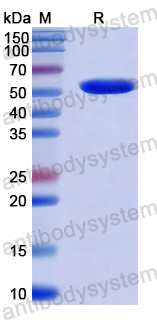Catalog No.
YHJ69901
Expression system
E. coli
Species
Homo sapiens (Human)
Protein length
Asn133-Ser351
Predicted molecular weight
51.45 kDa
Nature
Recombinant
Endotoxin level
Please contact with the lab for this information.
Purity
>90% as determined by SDS-PAGE.
Accession
Q9NZL4
Applications
ELISA, Immunogen, SDS-PAGE, WB, Bioactivity testing in progress
Form
Lyophilized
Storage buffer
Lyophilized from a solution in PBS pH 7.4, 0.02% NLS, 1mM EDTA, 4% Trehalose, 1% Mannitol.
Reconstitution
Reconstitute in sterile water for a stock solution. A copy of datasheet will be provided with the products, please refer to it for details.
Shipping
In general, proteins are provided as lyophilized powder/frozen liquid. They are shipped out with dry ice/blue ice unless customers require otherwise.
Stability and Storage
Use a manual defrost freezer and avoid repeated freeze thaw cycles. Store at 2 to 8°C for frequent use. Store at -20 to -80°C for twelve months from the date of receipt.
Alternative Names
Hsp70-binding protein 2, Hsp70-interacting protein 1, Hsp70-interacting protein 2, HSPBP, HspBP2, Hsp70-binding protein 1, HSPBP1, Heat shock protein-binding protein 1, HspBP1
SARS-CoV-2 S, M, and E Structural Glycoproteins Differentially Modulate Endoplasmic Reticulum Stress Responses., PMID:39940816
The role of heat shock proteins in HIV-1 pathogenesis: a systematic review investigating HSPs-HIV-1 correlations and interactions., PMID:39308823
HspBP1 in Complex with the Peptide of the Innate Immunity Protein Tag7 is Able to Lyse Tumor Cells Carrying TNFR1 Receptor., PMID:38189890
Zinc finger and SCAN domain-containing protein 18 is a potential DNA methylation-modified tumor suppressor and biomarker in breast cancer., PMID:37223020
The Immunoprotection of OmpH Gene Deletion Mutation of Pasteurella multocida on Hemorrhagic Sepsis in Qinghai Yak., PMID:36977260
Expression of HSPA14 in patients with acute HIV-1 infection and its effect on HIV-1 replication., PMID:36845091
Identification of 5' upstream sequence involved in HSPBP1 gene transcription and its downregulation during HIV-1 infection., PMID:36581045
Nucleotide Exchange Factors for Hsp70 Molecular Chaperones: GrpE, Hsp110/Grp170, HspBP1/Sil1, and BAG Domain Proteins., PMID:36520302
HspBP1 is a dual function regulatory protein that controls both DNA repair and apoptosis in breast cancer cells., PMID:35387978
Concurrent changes in thermal tolerance thresholds and cellular heat stress response reveals novel molecular signatures and markers of high temperature acclimation in rainbow trout., PMID:34863487
Proteomic characteristics of beryllium sulfate-induced differentially expressed proteins in rats., PMID:34733481
Allosteric activation of Hsp70 reduces mutant huntingtin levels, the clustering of N-terminal fragments, and their nuclear accumulation., PMID:34600937
Accumulation of Endogenous Mutant Huntingtin in Astrocytes Exacerbates Neuropathology of Huntington Disease in Mice., PMID:34250577
Mechanisms of Action of the PGLYRP1/Tag7 Protein in Innate and Acquired Immunity., PMID:33959389
HSPBP1 facilitates cellular RLR-mediated antiviral response by inhibiting the K48-linked ubiquitination of RIG-I., PMID:33713958
Truncation of mutant huntingtin in knock-in mice demonstrates exon1 huntingtin is a key pathogenic form., PMID:32444599
The cognitive and speech genes are jointly shaped by both positive and relaxed selection in the human lineage., PMID:32387504
The Co-Chaperone HspBP1 Is a Novel Component of Stress Granules that Regulates Their Formation., PMID:32235396
The N-terminal sequence of murine PRMT5 variant 2 is required for Hsp70 interaction and CHIP ligase-mediated degradation., PMID:31103260
HspBP1 and anti-HspBP1 levels in the serum of HIV-infected individuals are associated to the disease progression., PMID:30786116
Nucleotide exchange factors Fes1 and HspBP1 mimic substrate to release misfolded proteins from Hsp70., PMID:29323280
Nucleotide Exchange Factors for Hsp70 Chaperones., PMID:29177659
Differential HspBP1 expression accounts for the greater vulnerability of neurons than astrocytes to misfolded proteins., PMID:28847953
Gene expression profiles and bioinformatics analysis of human umbilical vein endothelial cells exposed to PM2.5., PMID:28575702
Expression profile of heat shock proteins in placental tissues of patients with preterm prelabor rupture of membranes and spontaneous preterm labor with intact membranes., PMID:28497897
Potential contributions of heat shock proteins and related genes in sexual differentiation in yellow catfish (Pelteobagrus fulvidraco)., PMID:28243861
BAG2 Interferes with CHIP-Mediated Ubiquitination of HSP72., PMID:28042827
Circulating heat shock protein mRNA profile in gestational hypertension, pre-eclampsia & foetal growth restriction., PMID:27934802
The nucleotide exchange factors of Hsp70 molecular chaperones., PMID:26913285
Quantitative analysis of the interplay between hsc70 and its co-chaperone HspBP1., PMID:26713263
HSP70 binding protein 1 (HspBP1) suppresses HIV-1 replication by inhibiting NF-κB mediated activation of viral gene expression., PMID:26538602
Upregulation of heat shock proteins (HSPA12A, HSP90B1, HSPA4, HSPA5 and HSPA6) in tumour tissues is associated with poor outcomes from HBV-related early-stage hepatocellular carcinoma., PMID:25798051
GrpE, Hsp110/Grp170, HspBP1/Sil1 and BAG domain proteins: nucleotide exchange factors for Hsp70 molecular chaperones., PMID:25487014
Assessment of placental and maternal stress responses in patients with pregnancy related complications via monitoring of heat shock protein mRNA levels., PMID:25359312
HSP70-binding protein HSPBP1 regulates chaperone expression at a posttranslational level and is essential for spermatogenesis., PMID:24899640
Hierarchical functional specificity of cytosolic heat shock protein 70 (Hsp70) nucleotide exchange factors in yeast., PMID:24671421
Hsp70 cochaperones HspBP1 and BAG-1M differentially regulate steroid hormone receptor function., PMID:24454860
Molecular cochaperones: tumor growth and cancer treatment., PMID:24278769
Ubiquitination-dependent quality control of hERG K+ channel with acquired and inherited conformational defect at the plasma membrane., PMID:24152733
Changes in the transcriptome of morula-stage bovine embryos caused by heat shock: relationship to developmental acquisition of thermotolerance., PMID:23320502
Effect of exercise on the expression of HSPBP1, PGLYRP1, and HSPA1A genes in human leukocytes., PMID:23113305
Human heat shock protein 105/110 kDa (Hsp105/110) regulates biogenesis and quality control of misfolded cystic fibrosis transmembrane conductance regulator at multiple levels., PMID:22505710
Extracellular HspBP1 inhibits formation of a cytotoxic Tag7-Hsp70 complex in vitro and in human serum., PMID:22037021
Heat shock protein gene expression profile may differentiate between rheumatoid arthritis, osteoarthritis, and healthy controls., PMID:21417552
De novo 19q13.42 duplications involving NLRP gene cluster in a patient with systemic-onset juvenile idiopathic arthritis., PMID:21326309
The Hsc/Hsp70 co-chaperone network controls antigen aggregation and presentation during maturation of professional antigen presenting cells., PMID:21283720
The heat shock-binding protein (HspBP1) protects cells against the cytotoxic action of the Tag7-Hsp70 complex., PMID:21247889
Long-term exercises increase the concentration of HspBP1, a co-chaperone of 70-KDa heat shock protein., PMID:21165407
Heat-shock protein expression in leukemia., PMID:20694586
Heat shock protein 70-binding protein 1 is highly expressed in high-grade gliomas, interacts with multiple heat shock protein 70 family members, and specifically binds brain tumor cell surfaces., PMID:19659607

